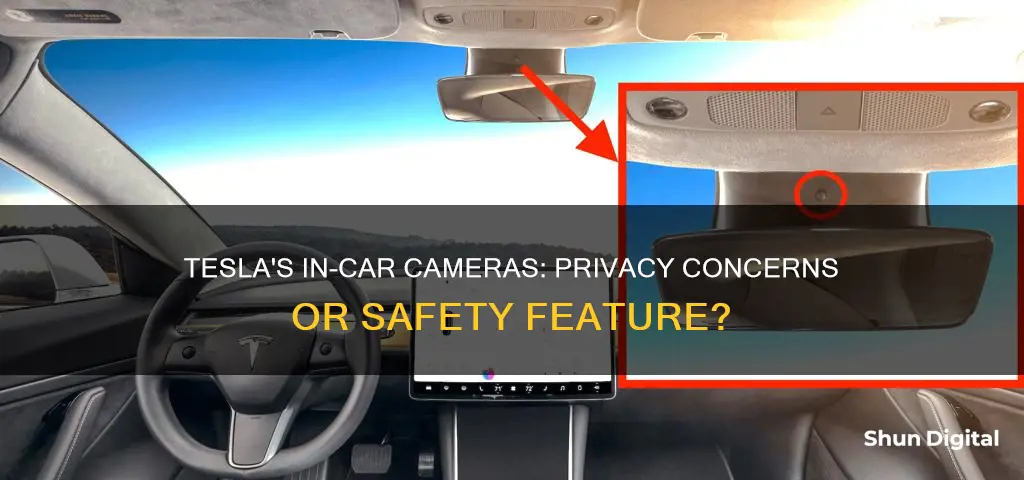
Tesla cars have a cabin camera located above the rear-view mirror, which is used to monitor driver attentiveness and provide audible alerts to remind drivers to keep their eyes on the road when Autopilot is engaged. While Tesla states that images and videos from the camera do not leave the vehicle itself unless data sharing is enabled, there have been reports of Tesla employees sharing sensitive videos and images recorded by the cabin cameras. This has raised concerns about customer privacy and consent. The cabin camera can be covered, but it may impact the use of certain features such as FSD (Full Self-Driving) and remote sentry mode.
| Characteristics | Values |
|---|---|
| Camera location | Above the rear-view mirror |
| Camera function | Determines driver inattentiveness and provides audible alerts |
| Data transmission | By default, images and video do not leave the vehicle itself and are not transmitted to anyone unless data sharing is enabled |
| Privacy | Tesla states that camera recordings remain anonymous and are not linked to the owner or vehicle |
| Data usage | Data is used to develop future safety enhancements and improve the intelligence of features that rely on the cabin camera |
What You'll Learn
- Tesla's cabin camera can determine driver inattentiveness and provide audible alerts
- Tesla owners can view the cabin camera feed from within the vehicle
- Tesla workers have shared images from car cameras, including scenes of intimacy
- Tesla's customer privacy notice says that camera recordings remain anonymous and are not linked to you or your vehicle
- Tesla drivers can opt out of data sharing in their privacy settings

Tesla's cabin camera can determine driver inattentiveness and provide audible alerts
Tesla vehicles are equipped with a cabin camera located above the rear-view mirror. This camera is designed to enhance safety and security. One of its key functions is to monitor driver attentiveness, particularly when Autopilot is engaged.
The cabin camera can detect if the driver is not paying attention to the road and provide audible alerts to remind them to keep their eyes on the road. This feature is available in the Model S (2021 or later), Model X (2021 or later), and Model Y. By monitoring the driver's behaviour, the cabin camera helps to improve road safety and reduce the risk of accidents caused by distracted driving.
In addition to monitoring driver attentiveness, the cabin camera also offers other benefits. For example, with the first update of 2023, Tesla provided the ability to view the cabin camera feed directly from within the vehicle. This feature gives users a better understanding of the camera's field of view and can provide peace of mind regarding their privacy.
It is important to note that Tesla prioritises user privacy. By default, images and videos captured by the cabin camera remain in the vehicle and are not transmitted externally, including to Tesla, unless data sharing is enabled by the user. Data sharing can be adjusted in the settings, and users can choose to enable or disable this feature at any time.
While the cabin camera is a valuable tool for enhancing safety and providing driver assistance, some users may have privacy concerns. To address this, Tesla allows users to control their data sharing preferences and provides transparency about how their data is used. Users can refer to their owner's manual for detailed information on the cabin camera and data sharing settings.
Red-Light Camera Tickets: Legality and Your Rights
You may want to see also

Tesla owners can view the cabin camera feed from within the vehicle
Tesla vehicles have a cabin camera located above the rear-view mirror. This camera was introduced with the Model 3 in 2017 but was only activated in 2021 to monitor drivers. The cabin camera can determine driver inattentiveness and provide audible alerts to remind you to keep your eyes on the road when Autopilot is engaged.
Tesla owners can now view the cabin camera feed from within the vehicle. This feature was added in the first software update of 2023 (version 2023.2.0.5). To access the cabin camera feed, owners can navigate to Controls > Service > Camera Preview on the in-car display. This allows owners to see what the camera can and cannot see when activated. It also helps owners adjust their rearview mirror to maximize visibility without obstructing the camera.
It is important to note that by default, images and video from the cabin camera do not leave the vehicle itself and are not transmitted to anyone, including Tesla, unless data sharing is enabled. If data sharing is enabled, and a safety-critical event occurs (such as a collision), Tesla may receive short cabin camera video clips to improve safety features and software enhancements. Owners can adjust their data sharing preferences by going to Controls > Software > Data Sharing > Allow Cabin Camera Analytics.
The Evolution of Cameras: From First Invention to Now
You may want to see also

Tesla workers have shared images from car cameras, including scenes of intimacy
Tesla cars have cabin cameras located above the rear-view mirror. These cameras are designed to monitor driver attentiveness and provide audible alerts to remind drivers to keep their eyes on the road when Autopilot is engaged. While Tesla assures its customers that their privacy "is and will always be enormously important", former employees have reported that Tesla workers shared images from car cameras, including "scenes of intimacy".
From 2019 to at least mid-2022, Tesla employees used an internal messaging system to share "highly invasive videos and images recorded by customers' car cameras", according to a Reuters report based on interviews with nine former Tesla employees. The report describes employees as having easy access to the cameras' output and sharing that freely with other employees. Some of the recordings caught Tesla customers in embarrassing situations, including a video of a man approaching a vehicle naked.
In addition to intimate scenes, employees also shared images of crashes and road rage incidents. One particularly disturbing example involved a video from 2021 that showed a Tesla hitting a child riding a bike in a residential area. The video spread through a Tesla office in San Mateo, California, via private one-on-one chats and sparked concerns about the potential invasion of customers' privacy.
While Tesla's customer privacy notice states that "camera recordings remain anonymous and are not linked to you or your vehicle", several former employees reported that the computer program they used could reveal the location of the recordings, potentially exposing customers' home addresses. This capability was described by one employee as a “massive invasion of privacy".
The sharing of these sensitive images and videos by Tesla workers has been criticised by privacy experts and lawyers as a possible violation of Tesla's own privacy policy and a breach of trust with its customers. As a result, Tesla may face scrutiny from privacy regulators and potential legal consequences for failing to uphold its privacy promises.
In response to these revelations, Tesla managers have reportedly cracked down on inappropriate sharing of images on public channels, claiming that the practice violated company policy. However, it is unclear if the sharing of recordings has completely ceased, as some former employees only observed sharing for legitimate work purposes.
Fixing Camera Focus Issues: Stay Sharp, Stay Focused
You may want to see also

Tesla's customer privacy notice says that camera recordings remain anonymous and are not linked to you or your vehicle
Tesla vehicles are equipped with a camera suite designed to protect your privacy while providing advanced features such as Autopilot, Smart Summon, and Autopark. The company asserts that it does not capture continuous recordings or have live-view functionality. By default, advanced autonomous features that rely on external cameras are processed without leaving your vehicle.
There are two types of camera recordings that are eligible to be transmitted from your vehicle to Tesla: Safety Event and Fleet Learning camera recordings. Safety Event camera recordings are automatically captured only if a serious safety event occurs, such as a collision or airbag deployment. These short clips are associated with your Vehicle Identification Number (VIN) to aid in providing emergency services, vehicle evaluation, and roadside assistance. They may also include timestamp and location metadata.
On the other hand, Fleet Learning camera recordings use the vehicle's external cameras to learn how to recognize things like lane lines, street signs, and traffic light positions. This type of recording requires your consent for Data Sharing, which can be controlled through the vehicle's touchscreen at any time. Even if you opt in, the camera recordings are limited to 30 seconds, remain anonymous, and are not linked to you or your vehicle.
Tesla's customer privacy notice emphasizes that camera recordings remain anonymous and are not linked to you or your vehicle. This means that even if Tesla employees access and share images or videos from car cameras, as reported by Reuters, the content remains decoupled from your personal information. However, it is worth noting that the practice of internal sharing of recordings may be a violation of Tesla's own privacy policy and is morally questionable.
To further protect your privacy, Tesla does not associate your location with your account or keep a history of where you have been. Additionally, the company provides you with the ability to enable or disable data sharing from your vehicle's touchscreen, giving you control over what information you share.
Fine-Tuning Your Wyze Camera Focus: Tips and Tricks
You may want to see also

Tesla drivers can opt out of data sharing in their privacy settings
Tesla vehicles are equipped with a camera suite designed to protect your privacy while providing advanced features such as Autopilot, Smart Summon, and Autopark. The cabin camera, located above the rear-view mirror, can determine driver inattentiveness and provide audible alerts to remind you to keep your eyes on the road when Autopilot is engaged.
By default, images and video from the cabin camera do not leave the vehicle itself and are not transmitted to anyone, including Tesla, unless you enable data sharing. This means that Tesla drivers can choose to opt out of data sharing. If you enable data sharing and a safety-critical event occurs (such as a collision), Tesla vehicles can share short cabin camera video clips to help develop future safety enhancements and continuously improve the intelligence of features that rely on the cabin camera.
To protect your privacy, images and video from the cabin camera are not associated with your vehicle identification number (VIN) and are not linked to your identity or account. You can adjust your data-sharing preferences at any time by tapping 'Controls' > 'Software' > 'Data Sharing' > 'Allow Cabin Camera Analytics' on your vehicle's touchscreen. Additionally, you can enable or disable the collection of certain vehicle data, such as Autopilot Analytics & Improvements and Road Segment Data Analytics, through the vehicle's touchscreen.
While Tesla provides the option to opt out of data sharing, it is important to note that certain advanced features and functionality may be impacted. As mentioned earlier, data sharing can help improve safety features and enhance the driving experience. By opting out, you may not receive real-time notifications about issues with your vehicle, which could result in reduced functionality or even serious damage. Therefore, while Tesla respects your privacy choices, it is essential to understand the potential consequences of disabling data sharing.
Charging Polaroid Snap Cameras: A Quick Guide
You may want to see also
Frequently asked questions
Yes, some Tesla vehicles have a cabin camera located above the rear-view mirror. This includes the Model S (produced in 2021 or later), Model X (produced in 2021 or later), and Model Y.
The cabin camera can determine driver inattentiveness and provide audible alerts to remind you to keep your eyes on the road when Autopilot is engaged. It can also be used to remotely look inside the cabin when the vehicle is parked and locked.
By default, images and videos from the cabin camera do not leave the vehicle itself and are not transmitted to anyone, including Tesla, unless you enable data sharing. If you choose to enable data sharing, Tesla may receive short cabin camera video clips in the event of a safety event, such as a collision, to help develop future safety enhancements.







